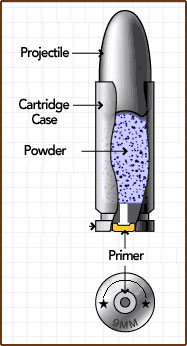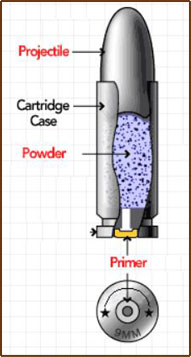

Starline is the maker of America's finest brass cases for reloading ammunition. Many American shooters are now reloading brass, something Starline has always known would maximize a shooter's dollar. Starline would like to help our first-time reloading friends better understand some of the common terms associated with reloading as they learn how to reload ammo.
A round of ammunition, or a loaded cartridge, consists of a projectile (bullet), a case, powder, and a primer.
These components of the round of ammunition have been called: rounds, cases, cartridges, brass, empties, shells, reloads, reloading brass, spent cases or brass cases. Regardless of the name, Starline manufactures these components. The case has a head on one end that houses the primer and seals the back of the chamber. The flash hole is the hole connecting the primer pocket to the inside of the case. This head can be of several different designs such as belted, rimless, semi-rimmed, rimmed, and rebated (meaning the diameter of the rim is smaller than that of the body). Besides sealing the back of the chamber, the head of the case is used to extract the case from the chamber.
There are three sizes of primer pockets that Starline uses; small rifle/pistol, large pistol, and large rifle. The small rifle and small pistol use the same diameter and depth primer pocket. The large rifle pocket is slightly deeper than the large pistol pocket. The body of the case will be one of three styles; straight, tapered or bottlenecked. The bottleneck cases will have a shoulder that steps down to a smaller diameter, while the tapered case will have a slight taper to achieve proper diameter. Straight wall cases are uniform diameter all the way up the body. The inside of the case will be of uniform thickness from the case mouth down to just past where the base of the bullet will seat. It will then become gradually thicker toward the bottom ending in a radius. The area of material between the bottom of the primer pocket and the bottom of this radius is called the web. STARLINE BRASS PRODUCES UNPRIMED BRASS FOR THE PURPOSE OF RELOADING AMMO. Order Online

Projectile - This component of the loaded round of ammunition is usually called the bullet. It is usually referenced by diameter (such as 9mm or .357"), the grain weight of the bullet, and the bullet style (hollow point, full metal jacket, etc.). A bullet is generally made of lead alloy with or without a jacket made of a copper alloy (some are produced with other materials for various purposes including frangible ammunition and lead free ammunition). STARLINE BRASS DOES NOT PRODUCE BULLETS.
Powder - Smokeless powder and black powder are the two basic forms of gunpowder. Black powder is a mixture of sulfur, charcoal and potassium nitrate. Smokeless powder is made with either a nitrocellulose base or a combination of nitrocellulose and nitroglycerin. Gun powder burns quickly once ignited. Rarely do we see terms other than powder used in the description of this material. STARLINE BRASS DOES NOT PRODUCE ANY POWDERS.
Primer - The primer is a round device that is placed in the center of the "head" area of the cartridge case. The firing pin strikes the primer and ignites the sensitive priming mixture causing a flame to be generated. Rarely do we see other terms used in the description of ammunition primers. STARLINE BRASS DOES NOT PRODUCE PRIMERS.
When a firearm is fired - The firing pin indents the primer, which ignites the priming compound, sending a flame through the flash hole of the brass, which ignites the powder. The quickly burning powder then creates large amounts of gas that expand the case to seal the chamber and pushes the bullet down the barrel. The now empty brass case is then removed manually or by the action of the firearm.